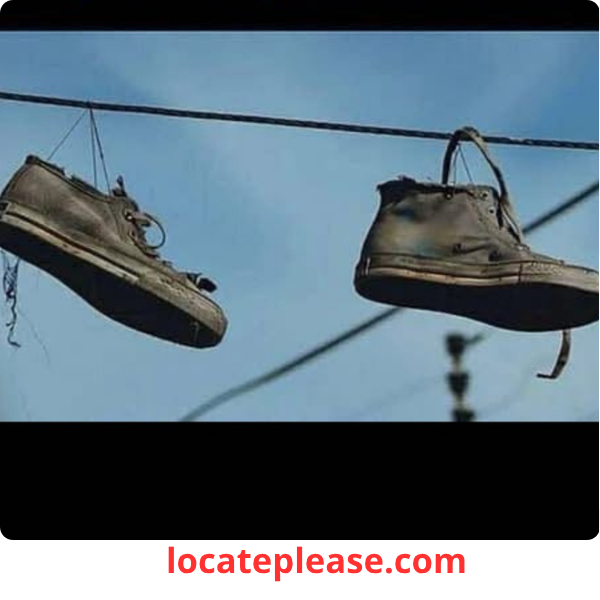Drive through any city, walk down a suburban street, or stroll through a college neighborhood, and you might spot them:
A pair of sneakers, dangling from a power line, swinging gently in the breeze like forgotten ghosts of the everyday.
It’s one of the most enduring and puzzling sights of modern urban landscapes — seen from Los Angeles to London, Sydney to São Paulo.
But what does it mean?
Is it a gang signal?
A memorial?
A prank gone viral?
Or just kids being kids?
For decades, the mystery of shoes on power lines has fueled speculation, folklore, and urban legends. While there’s no single answer, the truth is a mix of tradition, symbolism, mischief, and myth.
Let’s unravel the stories behind this curious phenomenon.
Top Theories Behind Shoes on Power Lines
1. Gang Territory or Drug Activity (The Most Controversial Theory)
Claim:
The shoes mark gang turf, signal a drug-selling spot, or indicate where weapons are stashed.
Reality:
While this theory is popularized by movies and TV shows (like The Wire), law enforcement and researchers say it’s largely overblown.
- Some isolated cases have linked shoe-tossing to crime, but these are rare.
- Most utility companies and police departments agree: the vast majority of shoe hangings have nothing to do with gangs.
👉 Verdict: More Hollywood myth than street reality.
2. Rite of Passage or Milestone Celebration
One of the most heartwarming explanations — shoes are tossed to mark a major life event.
Common examples:
- Graduation: High school or college seniors throw their shoes after their final day.
- Military deployment: Soldiers toss boots before shipping out.
- Leaving the neighborhood: A symbolic goodbye to childhood.
- Sports victories: Teams celebrate wins by launching sneakers into the sky.
It’s a rite of passage — a physical “I was here” moment, like carving initials in a tree, but with more airtime.
3. Memorial for the Dead
In some communities, shoes on a line serve as a silent tribute to someone who has died — especially in cases of violence, accidents, or suicide.
The shoes may represent:
- The last steps the person took
- A symbolic elevation of the soul
- A way to honor memory in public space
This practice echoes other traditions — like leaving shoes at roadside memorials — and carries deep emotional weight.
💙 Note: If the shoes are paired neatly, it’s more likely a memorial than a prank.
4. Bullying or Pranks
Sometimes, the reason is less noble.
- Bullies steal a classmate’s shoes and toss them where they can’t be retrieved.
- Teens dare each other to throw shoes onto high lines.
- Students target a teacher’s house as a joke.
It’s a classic schoolyard prank — harmless to some, humiliating to others.
5. Just for Fun (The Most Likely Reason!)
Let’s be real:
Often, there’s no deeper meaning at all.
It’s just:
- A dare (“Bet you can’t get it up there!”)
- A boredom buster
- A quirky tradition passed down through generations
Like graffiti, chalk art, or tree swings, it’s a small act of urban expression — sometimes rebellious, sometimes joyful, always visible.
Where Did This Trend Start?
There’s no definitive origin, but several theories have traction:
🎖️ Military Roots
- WWII and Vietnam-era soldiers reportedly threw their boots over power lines or fences to celebrate the end of duty.
- Some say it symbolized leaving war behind.
🌆 Urban Folklore & Pop Culture
- The trend spread through word of mouth, college campuses, and TV shows.
- The Wire (2002–2008) famously linked shoe-tossing to drug activity — cementing the myth in popular culture.
🌍 A Global Phenomenon
- Found in the U.S., U.K., Australia, South Africa, and Europe.
- Similar traditions exist in military bases, schools, and housing projects worldwide.
Is It Illegal?
Technically, yes.
Most cities classify it as:
- Littering
- Tampering with utility infrastructure (even if the line is just a cable)
- A potential safety hazard — tangled shoes can interfere with maintenance or cause shorts
Utility companies occasionally cut down the shoes, but many remain for years, becoming unofficial landmarks.
Final Thoughts: A Shoe Story for Every Line
Next time you see a pair of sneakers dangling from a wire, don’t just assume the worst.
That lone sneaker might mark:
- A teen’s first day of freedom
- A soldier’s return from war
- A life lost too soon
- Or just a really good throw
The truth?
It’s probably whatever you want it to be.
Because in the end, shoes on a power line aren’t just trash.
They’re urban poetry — small, silent stories written in canvas and laces, hanging in the sky.
So the next time you spot them… pause. Look up. And wonder: What’s their story?










